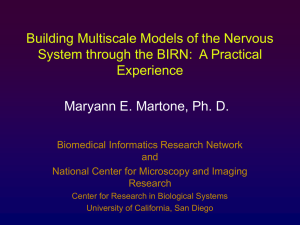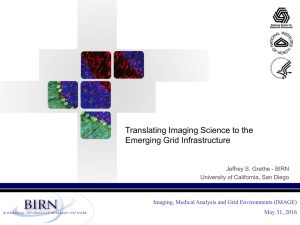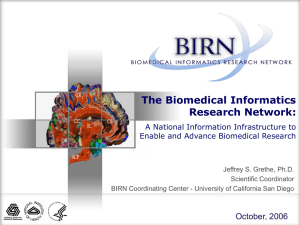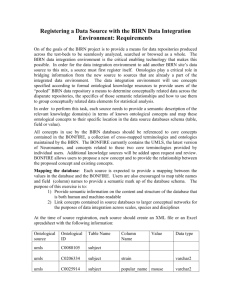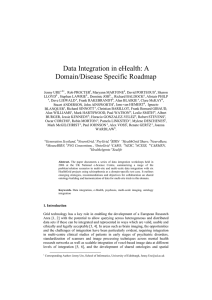The Biomedical Informatics Research Network: Data Management Infrastructure for Biomedical Research
advertisement
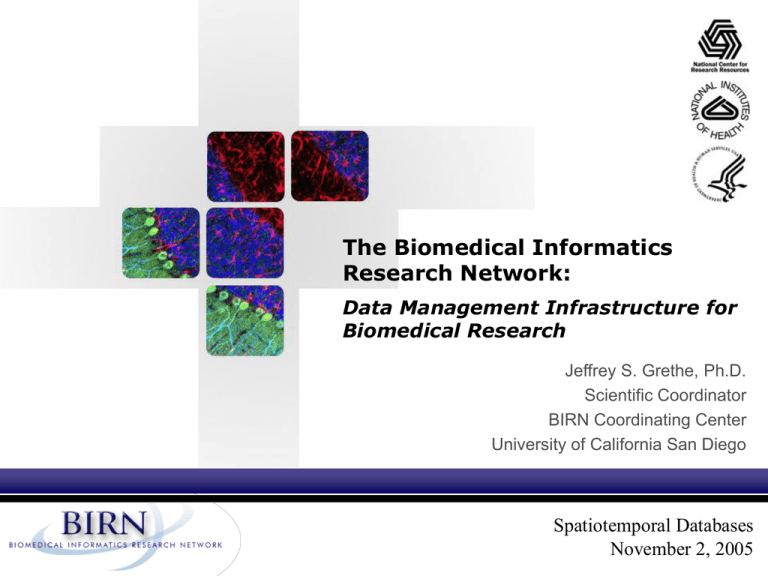
The Biomedical Informatics Research Network: Data Management Infrastructure for Biomedical Research Jeffrey S. Grethe, Ph.D. Scientific Coordinator BIRN Coordinating Center University of California San Diego Spatiotemporal Databases November 2, 2005 Biomedical Informatics Research Network A Shared Biomedical IT Infrastructure to Hasten the Derivation of New Understanding and Treatment of Disease through use of Distributed Knowledge • Connect distributed multi-scale biomedical data and researchers • Open access to data and tools • Bring Transparent GRID Computing to Biomedical Research • Grow Interdisciplinary Biomedical Informatics Workforce >Translation Overview of the BIRN-CC Roadmap • Be the vehicle for bringing advanced cyberinfrastructure to the larger biomedical community • Deliver and maintain a robust and scalable PRODUCTION Grid for the collaborative sharing, analysis and interrogation of biomedical data • Provide integrated solutions for core BIRN functions • Provide a consistent and scalable delivery mechanism BIRN has developed an “End-to-End” Production Infrastructure in the context of distributed biomedical research projects. BIRN-CC Enables Test Bed Science • A stable, robust, shared network and distributed database environment • Extensible tools and IT infrastructure that can be reused. • Established cyberinfrastructure for data grid and large scale data integration effort • High performance connectivity between distributed resources (computation and data storage) • Seamless access to distributed high performance computing resources Changing the use pattern for research data from the individual laboratory/project to shared use. The BIRN Collaboratory Today Enabling collaborative research at 28 research institutions comprised of 37 research groups. Data Requirements • From file sharing to data integration… • Science questions being addressed require integration of data from multiple subdisciplines, across scales, from different instruments, and different specimens • Data modeling and information integration techniques can be employed to enable scientists to access data more easily across distributed, heterogeneous sources • Integration is needed in order to: • Relate data from multiple scales • Obtain larger population sample across multiple universities, so that the findings are statistically more robust • Combing different categories of data, e.g. genomics data with neuro-imaging and molecular distribution data in the new phase of mouse BIRN, that provide different types of information • Compare animal models with human equivalents of a disease • Link BIRN data with other external sources of information • Requires a broad range of technologies – from distributed data collections, database integration, to use of semantic information, to use of scientific workflow environments and an environment to access these technologies Providing an Intuitive Interface to the BIRN Collaborative Environment Distributed Computation Data Management Data Visualization The BIRN shared information technology infrastructure for basic and translational research is available to all researchers from any internet capable location. BIRN Supports Grid Portal Technology The BIRN-CC is supporting development of the leading opensource standards-based grid portal. BIRN is Enabling Secure Collaboratories Single sign-on and credential management Full access control and audit logs for all data within the BIRN infrastructure Authentication service available to all BIRN applications The BIRN Coordinating Center is deploying a common authentication and security infrastructure. •Provides for Single Sign-On to access all portal, data and computational resourcees •Available to all BIRN applications •Will provide access to external resources (e.g. OptiPuter and TeraGrid) Enabling Large Scale Data Sharing • BIRN Data Grid: a Distributed Data Handling System built utilizing the Storage Resource Broker (SRB) • Data has more than doubled in the last year BIRN Data Grid Usage 14000 12000 10000 8000 6000 4000 2000 0 12.5 Terabytes Aug-05 Jun-05 Apr-05 Feb-05 Dec-04 8.4 million files Oct-04 • Provides a scalable and distributed solution for distributing publicly available data Total Number of Files (in thousands) Total Number of Files (in thousands) Total Size of Storage (in Gigabytes) BIRN Production Data Grid • Minimize single points of failure • Mirrored MCAT enabled servers • Oracle RAC • Monitoring of data gird and distributed hardware • Usability • Parallel and bulk transfers • Data verification • Data synchronization • Future • Hierarchical (distributed) MCAT BIRN Data Grid Integration • Coordinated suite of tools and interfaces to interact with the BIRN Data Grid • Programmatic interfaces - e.g. JARGON Java API • Command Line access • Graphical User Interface • Java BVDG Browser (local client) • Web BVDG Browser (remote server) • Contributed tools - e.g. SRBwrap from JHU • Allows researchers to tailor access to the data grid based on their requirements From outliers in univariate statistics, launch 3DSlicer to view anatomical data and use Query Atlas tool Java Grid Interface (Java Webstart) Integrating the Local Desktop • Java Grid Interface (JGI) provides wrapper for applications on a users desktop • Brokers communications and information/data transfer between the application and BIRN resources (e.g. BIRN Data Grid) • Allows for domain applications to be integrated with the BIRN infrastructure in a straightforward way • Improved version being developed in collaboration with Telescience for GridSphere Portal BIRN Testbeds - Overview Morphometry BIRN • Brain Structure in AD, MCI, Depression Function BIRN • Activation Differences in Schizophrenia Mouse BIRN • High Resolution Imaging and Animal Models of Human Diseases BIRN-CC • Coordinating Center for Cyberinfrastructure Morphometry BIRN Anatomical Correlates of Psychiatric Illnesses • Unipolar Depression, Alzheimer’s Disease (AD) and Mild Cognitive Impairment (MCI) Site and Platform Independent Acquisition and Analysis for Pooling Data • Multi-Site Clinical Studies • Increase Statistical Power for Rare Populations or Subtle Effects Normal Elderly Control Advanced Image Analysis and Visualization MGH, BWH, Duke, UCLA, UC San Diego, Johns Hopkins, UC Irvine, Wash U, MIT Alzheimer’s Individual Challenges of Large and Distributed Data • Art Toga was one of the first to articulate the magnitude of the challenge of human brain data Each Brain is Big Data and Comparisons Must be Made Between Many! SASHA Project Semi Automatic SHape Analysis (SASHA) 4 3 MGH Segmentation JHU Shape Analysis of Segmented Structures 5 BWH Visualization TeraGrid 1 Data Donor Sites De-identification And upload Data Grid 2 Goal: comparison and quantification of structures’ shape and volumetric differences across patient populations SASHA Project: Accomplishments Large Deformation Diffeomorphic Metric Mapping (LDDMM) using the TeraGrid Each LDDMM comparison takes about 3 to 8 hours Completed analysis of scaled run of 45 subjects • Examining hippocampus - clustering and disease detection in senile dementia (control, Alzheimer's, semantic dementia) • 30,000 CPU hours, 4 TB data Being applied in Mouse BIRN test bed - Fragile X mouse model Successful classification of the different subject groups through the utilization of non-invasive imaging methodologies potentially provides clinicians with new tools to assist them in their daily work Function BIRN Overview Calibration Methods for Multi-Site fMRI • • Study Regional Brain Dysfunction and Correlated Morphological Differences Progression and Treatment of Schizophrenia Human Phantom Trials • • • Common Consortium Protocol 5 Subjects Scanned at All 11 Sites Add'l 15 Controls, 15 Schizophrenics Per Site Per Year Statistical Techniques • • Identify Cross-Site Differences Develop Corrections to Allow Data Pooling Develop Interoperable Post-Processing UC Irvine, UCLA, UC San Diego, MGH, BWH, Stanford, UMinnesota, UIowa, UNew Mexico, Duke/UNorth Carolina, MIT fBIRN Multi-Site Data Example Reference Anatomical Scan fMRI Scans from 10 Different Sites • Same Subject, Registered, Same Slice Calibration Human Imaging Database fBIRN Analysis Infrastructure •Result Images in SRB FMRI Images Automated Image Upload to SRB/HID for sharing SRB/ Local fMRI Scanner FIPS: FSL Image Processing Scripts FIPS Results HIDB •Results with standard descriptions in HIDB •Clinical Data •Computer Aided Scale Input (CALM/GAME) •Clinical Data Entry Interface User Query Mouse BIRN Studying animal models of disease across dimensional scales to test hypothesis with human neurological disorders Experimental Allergic Encephalomyelitis (EAE) mouse models characteristic of Multiple Sclerosis (MS) Dopamine Transporter (DAT) knockout mouse for studies of schizophrenia, attention-deficit hyperactivity disorder (ADHD), Tourette’s disorder, and substance abuse Using an alpha-synuclein mouse to model the symptoms/pathology of Parkinson’s Disease Cancer animal models consortium with astrocytoma mouse model: NCI supported with Terry Van Dyke @ Duke • Cal Tech, Duke, UCLA, UCSD, Univ. Tenn Multiscale Data Integration 1. Databases at each site 4. Use mediator to navigate and query across data sources 2. Create conceptual links to a shared ontology 3. Situate the data in a common spatial framework Spatial Registration of Data Processing stream for spatial registration of brain volumes using the LONI pipeline, UCLA: David Rex, Allan MacKenzie-Graham Volume and slice data brought into register in order to correlate cellular and subcellular changes with noninvasive imaging Integrating Data using the BIRN Data Integration Environment Mediator Query Builder Integration with BIRN Test Bed Applications (e.g. Mouse BIRN) The BIRN mediator, a core component of BIRN 2.0, provides: •Enhanced user tools for registration, view definition and query building •Improved performance •Support for PostgreSQL databases •Integrated with BIRN authentication infrastructure Expert Knowledge Purkinje cell dendrite Molecular layer Purkinje cell body Cerebellar cortex Purkinje cell layer Parallel fiber Granule cell layer Granule cell Expert (Domain) Knowledge “Find proteins located in cerebellar cortex” The Smart Atlas: Spatial Integration over Distributed Data http://www.nbirn.net

